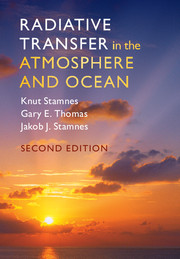Book contents
- Frontmatter
- Contents
- List of Illustrations
- List of Tables
- 1 Basic Properties of Radiation, Atmospheres, and Oceans
- 2 Basic State Variables and the Radiative Transfer Equation
- 3 Basic Scattering Processes
- 4 Absorption by Solid, Aqueous, and Gaseous Media
- 5 Principles of Radiative Transfer
- 6 Formulation of Radiative Transfer Problems
- 7 Approximate Solutions of Prototype Problems
- 8 The Role of Radiation in Climate
- 9 Accurate Numerical Solutions of Prototype Problems
- 10 Shortwave Radiative Transfer in the Atmosphere and Ocean
- Appendix A Nomenclature: Glossary of Symbols
- Appendix B Physical Constants
- Appendix C Ocean Optics Nomenclature
- Appendix D Reflectance and Transmittance at an Interface
- References
- Index
1 - Basic Properties of Radiation, Atmospheres, and Oceans
Published online by Cambridge University Press: 13 July 2017
- Frontmatter
- Contents
- List of Illustrations
- List of Tables
- 1 Basic Properties of Radiation, Atmospheres, and Oceans
- 2 Basic State Variables and the Radiative Transfer Equation
- 3 Basic Scattering Processes
- 4 Absorption by Solid, Aqueous, and Gaseous Media
- 5 Principles of Radiative Transfer
- 6 Formulation of Radiative Transfer Problems
- 7 Approximate Solutions of Prototype Problems
- 8 The Role of Radiation in Climate
- 9 Accurate Numerical Solutions of Prototype Problems
- 10 Shortwave Radiative Transfer in the Atmosphere and Ocean
- Appendix A Nomenclature: Glossary of Symbols
- Appendix B Physical Constants
- Appendix C Ocean Optics Nomenclature
- Appendix D Reflectance and Transmittance at an Interface
- References
- Index
Summary
Introduction
This chapter presents a brief overview of the spectra of the shortwave solar and longwave terrestrial radiation fields and the basic structure of atmospheres and oceans. Some general properties of the emission spectra of the Sun and the Earth are described. Their broad features are shown to be understandable from a few basic radiative transfer principles. We introduce the four basic types of matter which interact with radiation: gaseous, aqueous, particles, and surfaces. The stratified vertical structure of the bulk properties of an atmosphere or ocean are shown to be a consequence of hydrostatic balance. The vertical temperature structure of the Earth's atmosphere is shown to result mainly from radiative processes. Optical paths in stratified media are described for a general line-of-sight direction. Radiative equilibrium, the greenhouse effect, feedbacks and radiative forcing are introduced as examples of concepts to be dealt with in greater detail in Chapter 8.
The ocean's vertical temperature structure, and its variations with season are discussed as resulting from solar heating, radiative cooling, latent heat exchange, and vertical mixing of water masses of different temperature and salinity. Its optical properties are briefly described, along with ocean color. The last section prepares the reader for the notation and units used consistently throughout the book. Finally in the last section, we describe the conventions used for the various symbols which may depart from standard usage.
Parts of the Spectrum
In Table 1.1, we summarize the nomenclature attached to the various parts of the visible and infrared spectrum. The spectral variable is the wavelength. Here where c is the speed of light and ν is the frequency [s−1] or [Hz]. In the infrared (IR), is usually expressed in micrometers (where 1). In the ultraviolet (UV) and visible spectral ranges, is expressed in nanometers (1 nm = 10−9 m). A wavelength unit widely used in astrophysics and laboratory spectroscopy is the Ångström. For completeness we list both X-rays and the shorter-wavelength UV regions, even though they are not discussed in this book. A column lists the known solar variability, defined as the maximum minus minimum divided by the minimum in percentages.
- Type
- Chapter
- Information
- Radiative Transfer in the Atmosphere and Ocean , pp. 1 - 36Publisher: Cambridge University PressPrint publication year: 2017



